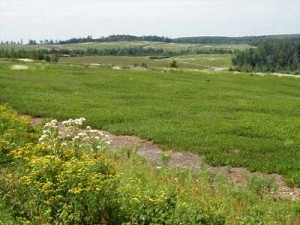Many people see design as creating new mechanical tools – better widgets for controlling space, flight, or grinding corn.
For me, design is creative problem solving.
Designing new mechanical tools is often a critical first step, but far from sufficient for creative problem solving. On our quest to help poor smallholders improve their livelihoods, we created useful tools such as treadle pumps and low cost drip systems. But they only addressed about 25% of the problem.
To solve the other 75% of the problem, an effective way to put these tools in the hands of millions of last mile customers had to be designed. This is as true of design in the West as it is for developing countries.

Since I’m now spending a delightful two weeks of vacation on my wild blueberry farm in Nova Scotia, I thought it might be interesting to describe my experience with a design problem in Canada: how to double or triple the yield of wild blueberry farms in Nova Scotia. I have learned that the recipe for accomplishing this requires a dash of new technology, and a very large portion of new agricultural strategy.
I bought a wooded 160 acre farm at Economy, Nova Scotia in 1999. The price was very reasonable, and the coastline of the Bay of Fundy is beautiful. Then I found out that the woods had lots of wild blueberries, and wild blueberries are the most important economic crop in Nova Scotia. After checking with local people, I learned how to convert wild blueberries in the bush to wild blueberries in the field and started the conversion process on sixty acres ten years
ago.
This year, I harvested my first blueberries. We hand-picked 2,260 pounds from an eight acre field, which I hope will increase rapidly to 32 tons or more from the same field a few years from now.
If it happens, this would represent double or triple the expected yield of one to two tons an acre for wild blueberries in Colchester County, Nova Scotia.
How do I expect to get there?
A mature wild blueberry field in Colchester County has more than 1,000 distinctly different species of blueberry plant. Each new blueberry plant multiplies rapidly through underground roots, and eventually forms a three-meter diameter circle of genetically identical plants, much like a clump of aspen. But each circle is different in blueberry yield – the most productive circle in a field might have 20 times as many berries per plant as the least productive.
A group of agriculture researchers at Kent State Agriculture College (http://www.gnb.ca/0171/10/0171100003-e.asp) studied this, and found that if you picked blueberries from the most productive circles in a field and grew blueberry seedlings by planting the seeds, yields on small test plots increased to around 11 tons an acre.
This is not surprising. People have been breeding horses and dairy cattle in the same way for years – it just hadn’t been applied to wild blueberries.
What the researchers recommended was to create fields of blueberries from bare fields by planting only “select clones.” This sounded interesting to me, so I checked it out.
In one of the chapters in my book, Out of Poverty, I described 12 steps for creative problem solving (P 13-24). The first three steps are the most important:
1. Go to where the action is
2. Talk to the people who have the problem, and listen to what they have to say
3. Learn everything there is to learn about the problem’s specific context
So I talked at length to the researchers at Kent State Agriculture College. I talked to the nursery that they hired to grow select clones. And I talked to as many farmers who tried out planting select clones as I could find.
I quickly learned that most of the farmers who tried planting select clones couldn’t make it work for them, for the following reasons:
1. It costs about $6,000 an acre to plant a field with select clones from scratch, and it
takes at least five years, even planted close together, to get the first crop. This is far too
expensive for most farmers in Nova Scotia.
2. Farmers in who planted select clones to help their developing blueberry fields fill in faster lost many of the seedlings to frost heaving, and most of the seedlings that survived frost heaving died within the first year. So, just about all the farmers who planted select clones became discouraged and quit using them.
I decided to call the nursery that was still selling select clone seedlings, and asked them to put me in touch with anyone who was successful using them.
They gave me the contact information for a grower in Prince Edward Island who kept ordering large numbers of select clones every year. So, I called him up and paid him a visit.
How do you get your seedlings to survive? I asked.
“That’s very simple,” he said. “You have to keep a dirty field.”
“What’s that?” I asked.
“For the first two years, the seedlings are very sensitive to herbicides used routinely in blueberry fields,” he said.
“So we plant them in a field full of weeds, and apply no herbicides for a couple of years. The weeds also prevent frost heaving.”
So I tried this, and it worked.
But instead of planting a whole field from scratch, I planted double rows of select clones about twenty feet apart in a field in the early stages of filling in.
This allowed us to keep the herbicides away from the rows we planted, and best of all, it cost less than $500 an acre, instead of the $6,000 an acre it would have cost to plant a field of select clones from scratch. My hope was that the select clones will spread and mix with the wild blueberries growing naturally in the field, and with cross pollination increase yields of wild blueberries already growing in the fields.

Even though the first yield this year was only 2,260 pounds, it has more than double what was expected. The blueberries we picked were plumper and heavier than average, and many of the plants were loaded with blueberries. We estimated this was true for about a quarter of the plants in the field.
My hope is that at a cost of about $500 an acre, we will eventually harvest four to five tons an acre instead of the normally expected one to two tons. Will this happen? I don’t know. But if it does, it will be yet one more example of applying two basic principles of successful design for the other 90%.
1. Before you start designing any tools or strategies, first go to where the action is, talk to the people who have the problem and listen to what they have to say, and learn everything there is to learn about the specific context.
2. Transformative affordable technology (like select clones) usually represents the solution to no more than 25% of the problem being addressed. The rest of the solution lies in designing new strategies, and new ways to deliver the technology to the people who need it.
Finally, I hope it demonstrates that design for the other 90% has just as much applicability to design for developed countries as it has for poor customers in developing countries.
Pingback: When do we start? « A Practicing Human
mr. polak…
you kill me 🙂
i have read your book a couple of times…i have given multiple copies away… great approach.
thanks for sharing your thoughts and ideas…the world is a better place with guys like you…
thanks rick- I’m delighted that you find my book useful
in a few months, I hope to have some new insights on how to build a profitable private business that serves poor customers in several countries
paul polak
Fantastic article! Your experiences and practical design philosophy are a constant inspiration and reminder that to practice design thinking, you do not have to steep yourself in the latest design school dogma. It seems like all the mental tools a practitioner really needs to be effective are curiosity, open-mindedness, creativity, but most of all the willingness to put forth the time and effort required to distill wisdom. Thank you for sharing your unique gifts and insights with a global audience. In my opinion, yours is one of the most valuable voices currently available to young people such as myself who want to use design-ish thinking to create positive change. How can we better utilize your successes to cultivate a sense of purpose into crumbling Western capitalist societies? Unfortunately, too many Know-Nothings here in the U.S. of A. know nothing about Buddhist philosophy and don’t seem to understand the fundamental relationship between cause and effect. How can design be used to create experiences that actually pollenate purpose and promote sustainable growth rather than desensitization? We young minds need your guidance.
Thanks Nate
I think you hit the nail on the head when you said you don’t need the latest design school dogma- you need curiousity, open mindedness and creativity!
One thing I’m trying to do is share what I have learned through some of these blogs. Do you have any suggestions on what kind of topics would be most useful to you?
paul polak